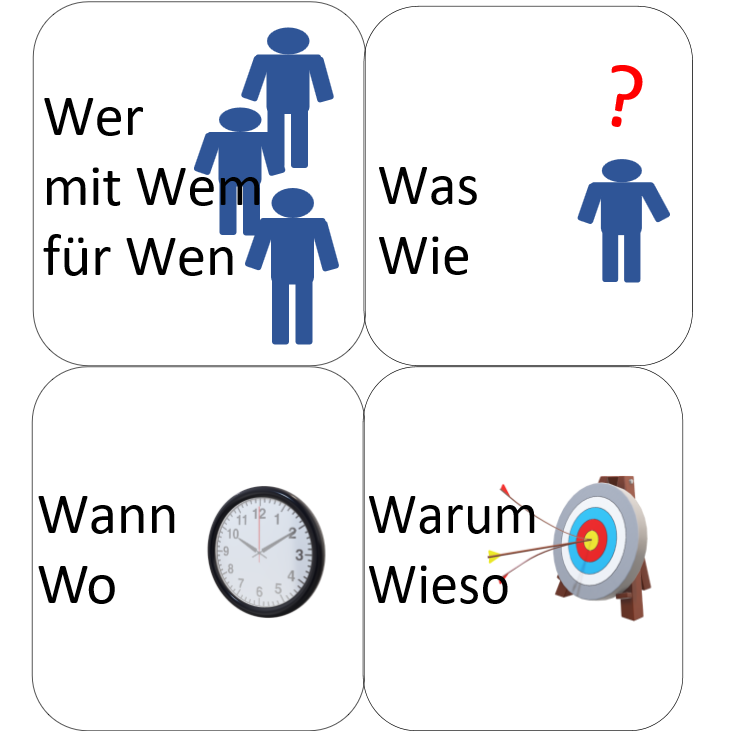The Question Square
Plan seminars efficiently with the Question Square
The Question Square
When planning a new seminar, there are many things to consider. The Question Square helps create structure and think through all important questions. By using the Question Square, the trainer is forced to go into more detail.

Who with whom for whom?
In the first quadrant of the Question Square, you address all questions related to people. These questions include:
- Who is conducting the seminar?
- Should the seminar be conducted by multiple trainers?
- Can the seminar be held alone, or is a partner needed (for specific subtopics)?
- Who can substitute for me if needed?
- Which target audience should be addressed?
The trainer should consider in advance whether they want and can conduct the seminar/training alone or if they should bring in a partner. This decision depends on various factors:
- Subject area
- Scope of the seminar
- Number of participants
- ...
There are pros and cons to conducting a seminar with multiple trainers.
Advantages:
- Seminar group can be split if needed
- Less workload per trainer
- Opportunity for more intensive individual coaching (This is a big advantage for more introverted participants)
Disadvantages:
- More organizational effort
- Possible compromises in seminar design
It's advisable to have a substitute who can step in and lead the seminar in an emergency. Canceling planned dates at short notice is usually unnecessary and does not leave a good impression on clients.
What? How?
In the second quadrant, you define the topic and methods to be used:
- What should be taught?
- Which methods should be applied?
- What are the (individual) learning objectives?
- At which taxonomy levels should the individual (sub)topics be taught?
The topic is essential for every seminar. Once the trainer has chosen a topic, they need to consider which specific content and subtopics are particularly relevant. This can be determined using various creative techniques (a mind map is particularly useful here, as topics are already pre-grouped).
Next, analyze how the individual subtopics can be taught to achieve the best learning outcome for participants. There are various learning methods a seminar leader can incorporate into the training. These include different games, small group work, role-playing, etc. It's important to integrate these purposefully into the seminar flow.
When? Where?
In the third quadrant, you answer organizational questions:
- When is the seminar taking place?
- Where is the seminar taking place?
- How long does the seminar last?
- What are the start and end times?
- When will breaks be taken?
- What requirements must the seminar location meet?
- What equipment is needed?
- How much space is required?
- How should tables and chairs be arranged?
- Is there a place nearby to buy food?
- How is the public transport infrastructure?
- ...
The seminar leader should carefully consider the location and timing of the seminar. When will the training take place, how many days will it last, and how should the seminar room be set up? Ensure the seminar location has enough space for all participants and the trainer's equipment. Also, consider the surroundings. Participants should have the opportunity to get food during lunch breaks. The venue's accessibility by public transport should also be considered.
Why?
In the fourth and final quadrant, determine the motivation for potential participants to attend the seminar. Consider the following questions:
- What problems does the seminar solve?
- What goals does the seminar pursue?
- What benefits do participants gain from attending the seminar?
- Which needs of the participants are met?
The trainer should consider which problems they aim to solve for participants and how to address them. They should also be aware of the goals participants should achieve by attending the seminar.
The SMART formula can help the trainer set goals for the seminar. It can be used to define, plan, and implement goals in detail. The set goals must be achievable for all participants.
Conclusion
Carefully working through the Question Square ensures that the trainer has already established the complete external framework of the seminar. Now, the specific content development (e.g., in the form of a trainer guide) can take place.
